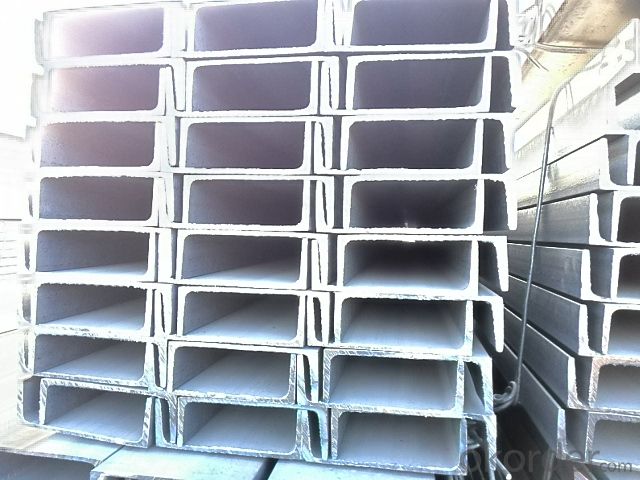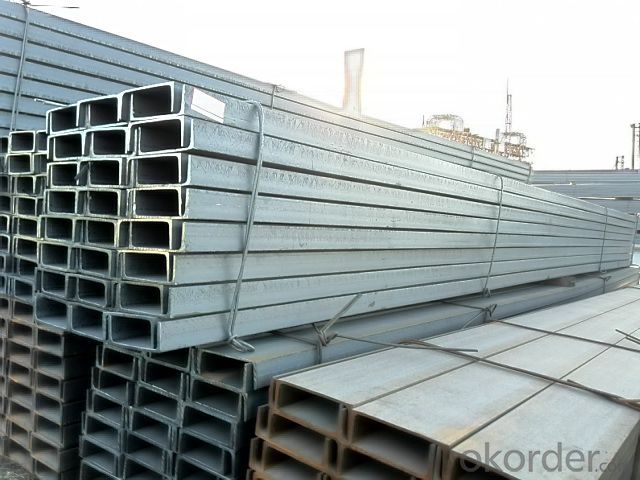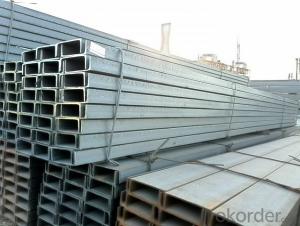U-channel Bars with High Quality and Good Price
- Loading Port:
- Tianjin
- Payment Terms:
- TT OR LC
- Min Order Qty:
- 25 m.t.
- Supply Capability:
- 10000 m.t./month
OKorder Service Pledge
OKorder Financial Service
You Might Also Like
Product Description:
| Minimum Order Quantity: | 25MT | Unit: | m.t. | Loading Port: | Xingang Port |
| Supply Ability: | 120000TON/Year | Payment Terms: | TT or LC |
Product Applications:
Hot Rolled U-channels are ideal for structural applications and are widely used in the construction of buildings and bridges, and the manufacturing, petrochemical, and transportation industries.
Product Advantages:
OKorder's Hot Rolled U-channels are durable, strong, and resist corrosion.
Main Product Features:
· Premium quality
· Prompt delivery & seaworthy packing (30 days after receiving deposit)
· Corrosion resistance
· Can be recycled and reused
· Mill test certification
· Professional Service
· Competitive pricing
Product Specifications:
Manufacture: Hot rolled
Grade: Q195 – 235
Certificates: ISO, SGS, BV, CIQ
Length: 6m – 12m, as per customer request
Packaging: Export packing, nude packing, bundled
1. We are definitely speciallizing in manufacturing and supplying channel steel as per japanese standard, which is characterised with high mechanical strength and competitive prices.
Original Place | Tangshan, China | Brand Name | UINDA |
Standard | JIS G3192 : 1990 | ||
Material Grade | SS490 | ||
Sizes | 50mm to 200mm | ||
Sales Volume/Year | 3000MT | ||
Destination Area | Middle East, Africa, Southeast Asia | ||
2. The sections in details are as followings in the table-1
JIS U CHANNEL | Standard | Sectional | Dimension |
| Mass: |
| (mm) | (mm) | (mm) | (mm) |
|
50x25 | 50 | 25 | 3.0 | 6.00 | 2.37 |
75X40 | 75 | 40 | 3.8 | 7.00 | 5.30 |
75X40 | 75 | 40 | 4.0 | 7.00 | 5.60 |
75X40 | 75 | 40 | 4.5 | 7.00 | 5.85 |
75X40 | 75 | 40 | 5.0 | 7.00 | 6.92 |
|
|
|
|
|
|
100X50 | 100 | 50 | 3.8 | 6.00 | 7.30 |
100X50 | 100 | 50 | 4.2 | 6.00 | 8.03 |
100X50 | 100 | 50 | 4.5 | 7.50 | 8.97 |
100X50 | 100 | 50 | 5.0 | 7.50 | 9.36 |
|
|
|
|
|
|
125X65 | 125 | 65 | 5.2 | 6.80 | 11.66 |
125X65 | 125 | 65 | 5.3 | 6.80 | 12.17 |
125X65 | 125 | 65 | 5.5 | 8.00 | 12.91 |
125X65 | 125 | 65 | 6.0 | 8.00 | 13.40 |
|
|
|
|
|
|
150x75 | 150 | 75 | 5.5 | 7.30 | 14.66 |
150x75 | 150 | 75 | 5.7 | 10.00 | 16.71 |
150x75 | 150 | 75 | 6.0 | 10.00 | 17.90 |
150x75 | 150 | 75 | 6.5 | 10.00 | 18.60 |
150x75 | 150 | 75 | 6.5 | 10.00 | 24.00 |
|
|
|
|
|
|
200X80 | 200 | 80 | 7.5 | 11.00 | 24.60 |
Table-1
3. The mechanical property of JIS U Channel Steel in the table-2:
Grade | Yield Strength,N/mm² | Extension Strength N/mm² | |||
Thickness of Steel,mm | |||||
≦16 | >16-≦40 | >40-≦100 | >100 | ||
SS490 | ≧285 | ≧275 | ≧255 | ≧245 | 490-610 |
Table-2
4. The chemical composition of JIS U Channel Steel as per SS490 in the table-3
Grade | Element(%) | |||
C | Mn | P | S | |
SS490 | - | - | ≦0.050 | ≦0.050 |
Table-3
FAQ:
Q1: Why buy Materials & Equipment from OKorder.com?
A1: All products offered byOKorder.com are carefully selected from China's most reliable manufacturing enterprises. Through its ISO certifications, OKorder.com adheres to the highest standards and a commitment to supply chain safety and customer satisfaction.
Q2: How do we guarantee the quality of our products?
A2: We have established an advanced quality management system which conducts strict quality tests at every step, from raw materials to the final product. At the same time, we provide extensive follow-up service assurances as required.
Q3: How soon can we receive the product after purchase?
A3: Within three days of placing an order, we will begin production. The specific shipping date is dependent upon international and government factors, but is typically 7 to 10 workdays.
Images:



- Q:How do steel rebars contribute to the overall sustainability of the construction industry?
- Steel rebars contribute to the overall sustainability of the construction industry in various ways. Firstly, the use of steel rebars enhances the structural integrity and durability of concrete structures, ensuring their longevity and reducing the need for frequent repairs or replacements. This significantly reduces the amount of construction waste generated and minimizes the overall environmental impact. Additionally, steel rebars are recyclable materials, meaning they can be repurposed and reused at the end of their life cycle. This not only reduces the demand for new steel production but also lowers the energy consumption and greenhouse gas emissions associated with the manufacturing process. By promoting the circular economy, steel rebars help conserve natural resources and reduce the carbon footprint of the construction industry. Moreover, the use of steel rebars in concrete structures enhances their resistance to seismic activities and extreme weather conditions, such as hurricanes or earthquakes. This ensures the safety of the occupants and reduces the risk of damage to the infrastructure, thus minimizing the need for reconstruction and contributing to the overall resilience of the built environment. Furthermore, steel rebars can be engineered and designed to optimize the use of materials, reducing the overall weight of structures. This leads to more efficient transportation and installation processes, resulting in lower fuel consumption and transportation-related emissions. Lastly, steel rebars offer flexibility in design and construction, allowing for innovative and sustainable building solutions. They can be easily integrated into various construction methods, enabling the use of sustainable construction techniques such as prefabrication or modular construction. This enhances efficiency, reduces construction time, and minimizes disruption to the surrounding environment. In conclusion, steel rebars play a crucial role in the sustainability of the construction industry by enhancing the durability of structures, promoting recycling, reducing waste generation, conserving resources, improving safety, and enabling innovative construction techniques. Their use contributes to the overall environmental, social, and economic sustainability of the industry, making it a vital component in sustainable construction practices.
- Q:What is the lifespan of a steel rebar in a concrete structure?
- The duration of a steel rebar's existence within a concrete structure may differ due to various factors. Generally, a well-designed and properly constructed concrete structure with steel reinforcement can endure for 50 to 100 years or even longer. One critical factor that affects its lifespan is the quality of the concrete and its ability to shield the steel reinforcement from external elements. Concrete acts as a barrier, safeguarding the steel rebar from moisture, oxygen, and other potentially corrosive substances. However, if the concrete is of inadequate quality, contains excessive amounts of chloride or other aggressive chemicals, or is not adequately cured, it can result in the deterioration of the rebar and significantly reduce its lifespan. Another significant aspect is the exposure conditions to which the concrete structure is exposed. If the structure is situated in a harsh environment with high levels of humidity, exposure to saltwater, or industrial pollutants, it can expedite the corrosion process and decrease the rebar's lifespan. Proper maintenance and periodic inspections can also have a substantial impact on prolonging the steel rebar's lifespan within a concrete structure. Regular inspections can help identify any initial signs of corrosion or deterioration, enabling timely repairs or implementation of protective measures. To enhance the lifespan of steel rebar, additional protective measures can be taken during construction, such as applying corrosion-resistant coatings or utilizing stainless steel reinforcement. These measures can significantly extend the rebar's lifespan and improve the overall durability of the concrete structure. In conclusion, the lifespan of a steel rebar in a concrete structure can vary but generally falls within the range of 50 to 100 years or more, assuming the concrete is of good quality, the exposure conditions are not excessively severe, and proper maintenance and protective measures are implemented.
- Q:Are there any limitations on the maximum length of steel rebars used in construction?
- There are restrictions on the maximum length of steel rebars used in construction, which can vary based on factors like structural design, construction codes, and transportation limitations. Generally, the length of steel rebars is limited due to practical considerations such as handling, transportation, and installation. Very long rebars can be challenging to transport and maneuver on construction sites, and they may also be more susceptible to bending or sagging, thus compromising their structural integrity. Consequently, construction industry standards and codes typically establish guidelines or restrictions on the maximum length of steel rebars to guarantee their safe and efficient utilization in construction projects. Architects, engineers, and contractors must adhere to these limitations to ensure the building's structural stability and safety.
- Q:Can steel rebars be used in structures with limited construction regulations?
- Yes, steel rebars can be used in structures with limited construction regulations. Steel rebars are commonly used in construction due to their high tensile strength and durability. However, it is important to note that even in structures with limited regulations, it is crucial to follow basic safety guidelines and ensure proper engineering and construction practices to ensure the structural integrity and safety of the building.
- Q:What is the lifespan of steel rebars in concrete?
- The lifespan of steel rebars in concrete can vary depending on several factors, such as the quality of the steel used, the level of exposure to corrosive elements, and the maintenance and care given to the concrete structure. However, with proper design, construction, and maintenance, steel rebars in concrete can typically have a lifespan of 50 to 100 years or more.
- Q:What are the different methods of connecting steel rebars?
- There are various methods of connecting steel rebars, including lap splicing, mechanical splicing, and welding. Lap splicing involves overlapping the rebars and securing them with wire or tie bars. Mechanical splicing utilizes couplers or threaded sleeves to connect the rebars. Welding involves melting the rebars together to form a strong bond. Each method has its advantages and suitability depending on the specific requirements of the construction project.
- Q:How do steel rebars perform in heavy load-bearing structures?
- Steel rebars perform exceptionally well in heavy load-bearing structures. Due to their high tensile strength and durability, they provide crucial reinforcement to concrete, effectively distributing and resisting heavy loads. This ensures structural integrity, preventing deformation and collapse even under extreme conditions.
- Q:Are steel rebars suitable for use in hospital construction?
- Indeed, steel rebars are a suitable option for hospital construction. Referred to as reinforcing bars, steel rebars are commonly utilized in construction projects to impart strength and stability to concrete structures. In the context of hospital construction, where safety and durability are of utmost importance, steel rebars offer numerous benefits. First and foremost, steel rebars possess remarkable tensile strength, enabling them to endure heavy loads and resist deformation. This attribute is critical in hospital construction, where the edifice must support the weight of medical equipment, patients, and other infrastructure. Furthermore, steel rebars bolster the overall structural integrity of the hospital, guaranteeing long-term stability and safety. Moreover, steel rebars exhibit excellent fire resistance properties. Hospitals are classified as high-risk establishments, as they house potentially flammable materials and electrical equipment. Steel rebars can endure high temperatures without compromising their strength, thus enhancing the structure's fire protection. Additionally, steel rebars are resistant to corrosion, shielding the concrete from damage caused by moisture and chemicals. Hospitals often experience elevated humidity levels and exposure to various chemicals employed in medical procedures. Through the utilization of steel rebars, the risk of corrosion and subsequent structural deterioration is minimized, ensuring a prolonged lifespan for the hospital building. Lastly, steel rebars are easily obtainable and cost-effective. Hospital construction projects frequently adhere to strict timelines, and the use of steel rebars enables efficient construction and swift installation. Furthermore, the market's abundance of steel rebars ensures competitive pricing, rendering them a cost-effective choice for hospital construction. In conclusion, steel rebars are unquestionably suitable for employment in hospital construction. Their high tensile strength, fire resistance, corrosion resistance, and cost-effectiveness render them an ideal selection for guaranteeing the safety, durability, and long-term stability of hospital structures.
- Q:How do steel rebars prevent concrete structures from spalling?
- Steel rebars prevent concrete structures from spalling by providing reinforcement and increasing the tensile strength of the structure. When concrete undergoes temperature changes or experiences external forces, it tends to expand or contract, leading to cracking and spalling. However, with the presence of steel rebars, these forces are distributed throughout the structure, preventing the concrete from cracking and breaking apart. The rebars act as a support system, holding the concrete together and ensuring its stability and durability, thus preventing spalling.
- Q:How are steel rebars tested for tensile strength?
- Steel rebars are tested for tensile strength by subjecting them to a controlled amount of force, typically in a laboratory setting. This is done by placing the rebar in a specialized machine called a universal testing machine (UTM) that can apply an increasing load to the rebar until it reaches its breaking point. The UTM measures the amount of force required to break the rebar, which determines its tensile strength.
1. Manufacturer Overview |
|
|---|---|
| Location | |
| Year Established | |
| Annual Output Value | |
| Main Markets | |
| Company Certifications | |
2. Manufacturer Certificates |
|
|---|---|
| a) Certification Name | |
| Range | |
| Reference | |
| Validity Period | |
3. Manufacturer Capability |
|
|---|---|
| a)Trade Capacity | |
| Nearest Port | |
| Export Percentage | |
| No.of Employees in Trade Department | |
| Language Spoken: | |
| b)Factory Information | |
| Factory Size: | |
| No. of Production Lines | |
| Contract Manufacturing | |
| Product Price Range | |
Send your message to us
U-channel Bars with High Quality and Good Price
- Loading Port:
- Tianjin
- Payment Terms:
- TT OR LC
- Min Order Qty:
- 25 m.t.
- Supply Capability:
- 10000 m.t./month
OKorder Service Pledge
OKorder Financial Service
Similar products
New products
Hot products
Related keywords





























